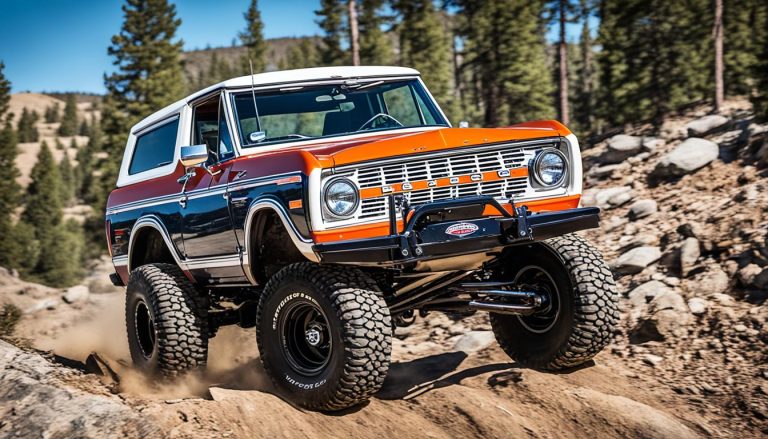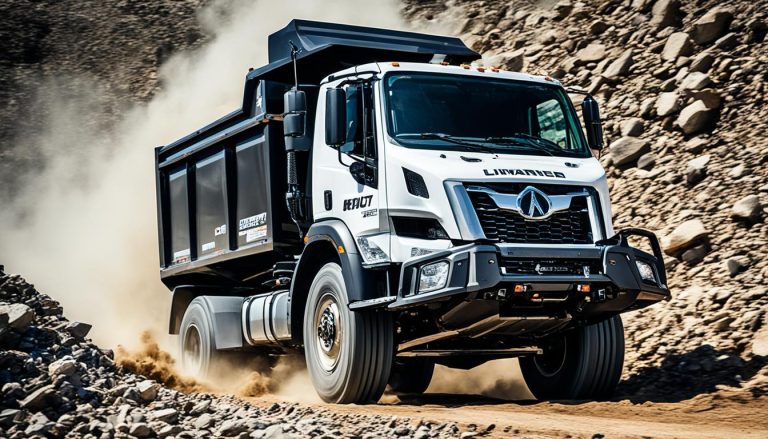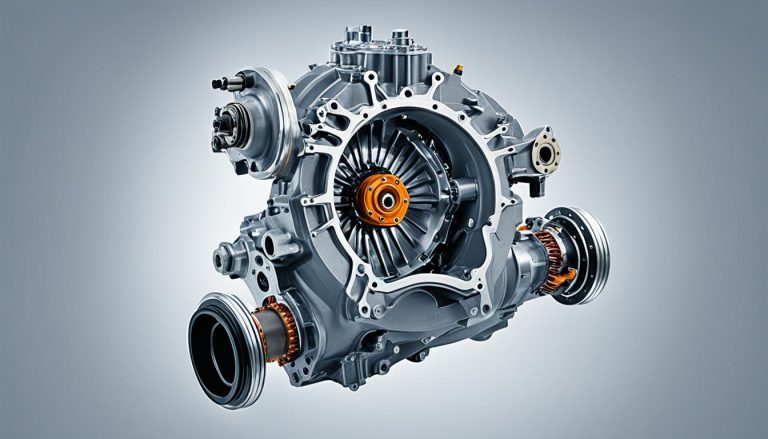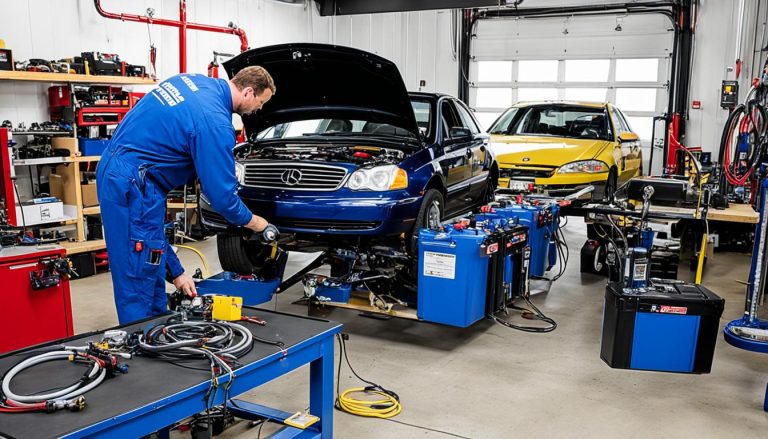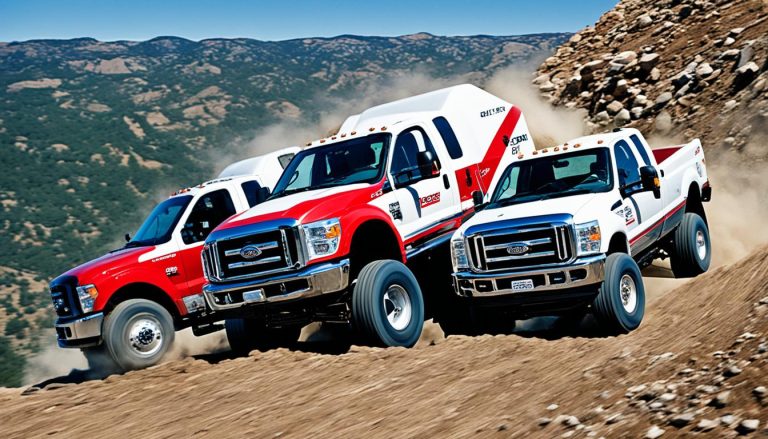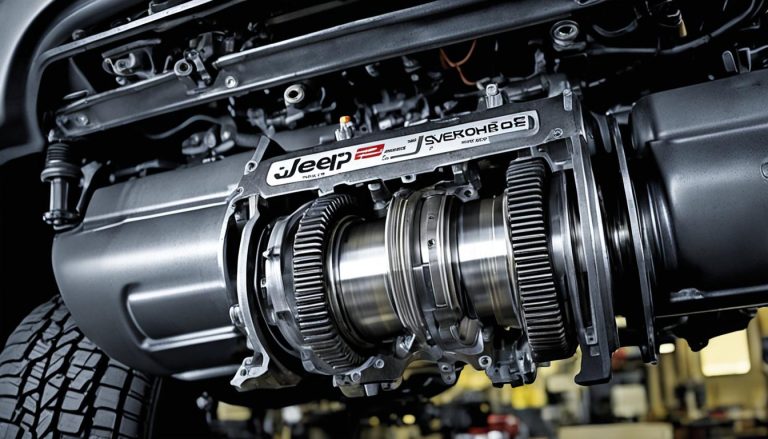Understanding the Purpose of Differential in Cars
Have you ever wondered how your car manages to take smooth turns without a hitch? Behind this seemingly simple action lies a complex and crucial component: the differential. Its purpose is instrumental in enhancing your vehicle’s performance and ensuring those turns feel effortless. As you steer into a curve, the differential function allows each wheel to rotate at different speeds, preventing the tires from skidding and maintaining optimal traction control. This nifty piece of engineering is essential for both your car’s agility and your safety on the road.
Key Takeaways
- The differential is critical for allowing wheels to spin at varying speeds, particularly in turns.
- Vehicle performance is enhanced by the differential, contributing to smoother and safer driving.
- Understanding differential function can help you appreciate the intricate mechanics of your car.
- Maintaining the differential ensures continued traction control and vehicle stability.
- Properly functioning differentials are key for managing the forces exerted during vehicle maneuvers.
Explaining the Basics of a Car Differential
As you delve deeper into the world of automotive mechanics, you’ll quickly realize the significance of differential systems in modern vehicles. Far from being just another component, the differential is key to dynamic vehicle handling, influencing everything from smooth turns to consistent wheel traction.
Defining the Differential and Its Role in Vehicle Dynamics
At its core, a differential is about balance and adaptability in moving parts. This ingenious set of gears is nestled between the drive wheels, tasked with a crucial function: enabling the wheel rotation at different speeds. It’s especially apparent during turns when the laws of physics dictate that the outer wheel must travel farther than the inner wheel. Thanks to the differential, your car can make turns smoothly, maintaining stability and grip on the road surface.
Understanding the mechanics of the front differential and rear differential is also essential. The front version operates in vehicles with front-wheel drives, allowing the front wheels to pivot and propel simultaneously. Contrastingly, the rear differential applies to rear-wheel vehicles, providing a similar balance at the back. More complex still is the centre differential, found in all-wheel-drive systems, ensuring power is evenly distributed among all four wheels.
Types of Differentials and Their Functions
Automakers often employ different forms of differentials based on specific vehicle requirements and performance goals. The versatile Torsen differential, with its sophisticated design, uses worm gears to distribute torque to the wheel with the most traction. It’s an asset in high-performance cars where optimal grip levels are non-negotiable.
Meanwhile, locking differentials are a mainstay in off-road vehicles. Their ability to lock the wheels’ speeds together means that even on the roughest terrains, both wheels can keep turning even if one has little or no grip.
The Science Behind Wheel Rotation and Traction Control
When it comes to wheel traction, the differential doesn’t just allow wheels to rotate independently; it plays a pivotal role in ensuring your vehicle can hold the road securely. This aspect of differential in physics is fundamental to safe and reliable driving.
Through sophisticated methods like torque vectoring, cars can now allocate power where it’s needed most — typically the outside wheels during a turn. This advanced level of control translates to more precise handling and a reduced risk of understeer, characteristics avid drivers appreciate.
So the next time you’re navigating a twisty road or facing a slick surface, remember the complex dance of gears beneath your feet. The intricate mechanics of your car’s differential system are working in concert to keep your ride smooth, and your turns as sharp as they need to be.
The Importance of Differential in Vehicle Handling
When you’re navigating through tight corners or cruising over varied terrains, have you ever wondered what automotive wizardry ensures your ride remains stable and responsive? The secret lies within your vehicle’s differential—a key component that significantly impacts handling precision, stability control, and overall safety mechanisms. The importance of differential cannot be overstated when it comes to enhancing your vehicle’s maneuverability and reliability.
The differential works silently, allowing each wheel to rotate at different speeds, especially when turning. This differential action lessens the strain on the drivetrain and greatly contributes to the handling precision of the vehicle. Not just that, it’s the unsung hero that collaborates with safety mechanisms and stability control systems to protect you during those unpredictable moments on the road.
Systems such as all-wheel drive and four-wheel drive are particularly dependent on the differential to master the art of stability and traction across diverse driving conditions, marking a pinnacle in vehicular safety and performance.
But how does this translate into real-world benefits? Let’s break down the attributes of a differential that cater to essential safety mechanisms and contribute to the overall stability control of your vehicle.
- Reduces tire wear: By allowing wheels to rotate at different speeds, a differential prevents unnecessary tire drag and wear during turns.
- Increases traction: Whether on loose gravel or slippery surfaces, the differential adjusts wheel speed to maintain traction.
- Enhances control: Tight corners demand precise wheel speeds. Differentials ensure this precision, granting you greater control over your vehicle.
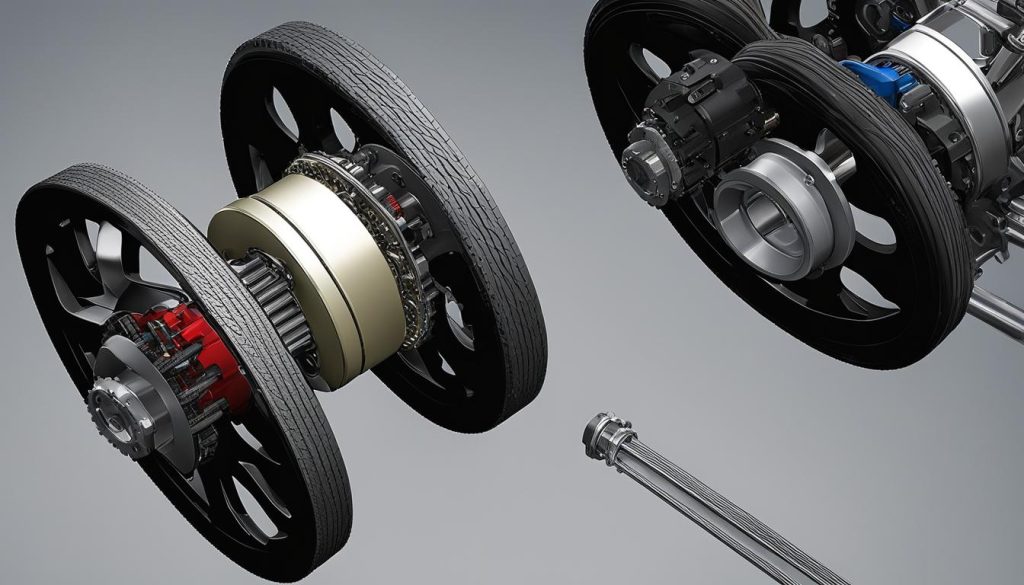
Below is a table that illustrates how the presence of a differential impacts crucial aspects of vehicle handling:
| Handling Attribute | With Differential | Without Differential |
|---|---|---|
| Cornering Precision | High precision due to variable wheel speeds | Poor as wheels turn at the same speed |
| Stability on Turns | Enhanced due to optimized traction | Compromised, can lead to skidding |
| Safety on Varied Terrain | Adaptive to changes, ensuring safety | Higher risk of loss of control |
| Drivetrain Stress | Minimized, leading to longer vehicle life | Increased, causing potential damage |
In conclusion, your vehicle’s differential is an indispensable facet of the mechanical ensemble that dictates the finesse of your drive. A testimony to the ingenuity of automotive engineering, the differential stands at the forefront, safeguarding your journey with superior stability control and sublime handling precision.
Purpose of Differential in Various Drive Configurations
As you delve into the world of automotive design, you’ll understand that the differential plays a pivotal role in your vehicle’s performance, particularly in different drive configurations. Whether you’re cruising in a front-wheel drive commuter or navigating tough terrain with a four-wheel drive SUV, the differential mechanism quietly orchestrates the power distribution and stability of your drive.
Diving into the distinct systems, such as front-wheel drive and rear-wheel drive platforms, the differential’s function is instrumental. In a front-wheel drive setup, typically paired with a transaxle, the differential is an integral part of the front assembly, working in unison with the transmission. This integration is key for torque-steer prevention. Meanwhile, vehicles equipped with rear-wheel drive rely on a differential situated strategically between the rear wheels, connected by a driveshaft, for balanced power distribution during dynamic maneuvers.
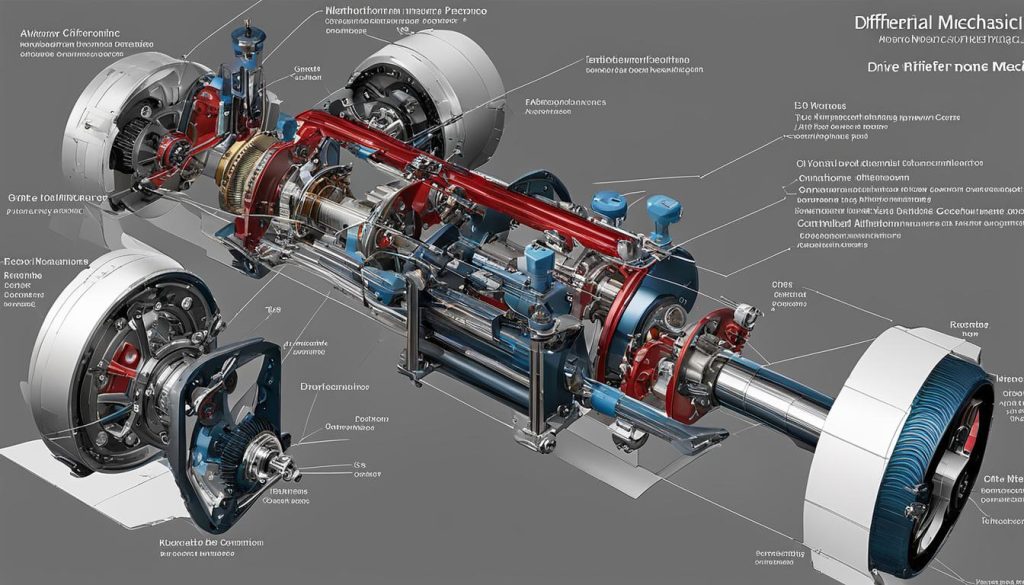
Differentials in Front-Wheel and Rear-Wheel Drive Systems
The essence of driving enjoyment often lies in how well the car handles bends and curves. In front-wheel drive vehicles, the differential is part of the transmission assembly, often referred to as a transaxle, which combines the functionality of the transmission and axle. Conversely, rear-wheel drive vehicles have their differentials located between the rear wheels, ensuring proper power distribution and handling stability, particularly during cornering.
The Role of Centre and Torsen Differentials in AWD and 4WD
On the adventurous side of the automotive spectrum, the all-wheel drive and four-wheel drive systems introduce more complex differential technologies. Vehicles like these are endowed with either a centre differential that manages power distribution between the front and rear axles, or a Torsen differential, renowned for its intelligent torque distribution capabilities. These components are the unsung heroes that equip your vehicle with superior traction, making them proficient across a variety of challenging surfaces.
Efficiency in Power Distribution: Limited-Slip and Locking Differentials
The dynamics of your car’s power distribution are further refined by the inclusion of limited-slip and locking differentials. A limited-slip differential stands as a guardian against wheel slip by redirecting torque to the wheel with the most traction—crucial for performance-oriented driving and an effective measure for torque-steer prevention. In the realm of off-road capability, locking differentials grant your vehicle the tenacity needed to traverse uneven landscapes by synchronizing the wheel speeds, ensuring maximum traction where it’s needed most.
Advanced Differential Technologies and Vehicle Performance
When it comes to elevating your vehicle’s capabilities, advanced differential technologies play a crucial role. These sophisticated systems, including electronic torque-vectoring and active differential systems, are integral for modern automobiles seeking substantial performance enhancements. Not only do these technologies adapt in real-time to driving conditions, but they also ensure that the power transfer to your wheels is optimized for the most agile and secure maneuvering possible.
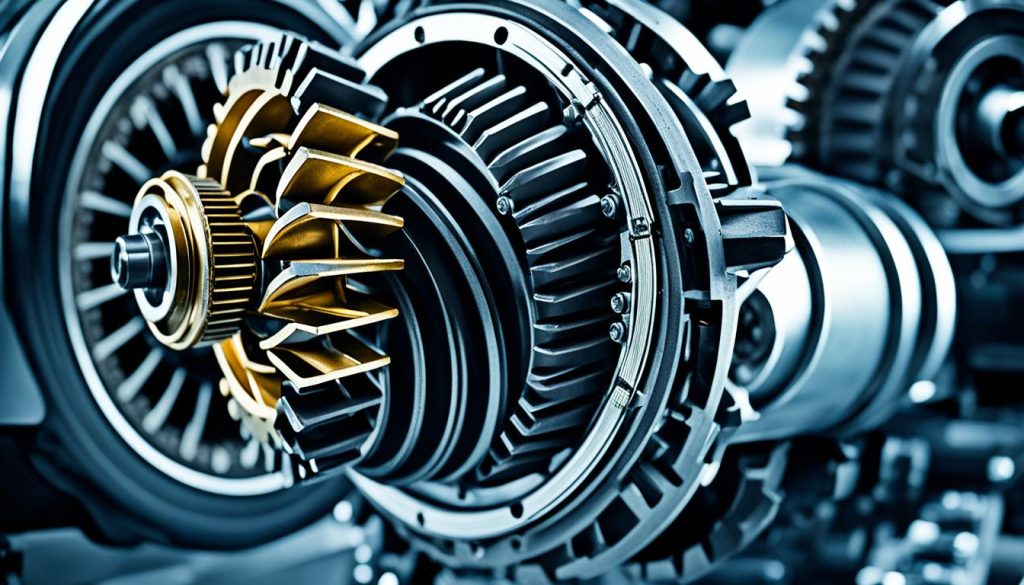
Imagine driving through a sharp turn or navigating a slippery road; it’s in these moments that the merits of an active differential system shine. By dynamically adjusting the degree of grip and wheel spin, this system maintains the perfect balance between speed and stability. Meanwhile, electronic torque-vectoring acts as a finetuned orchestrator, distributing torque to individual wheels during cornering to prevent understeer and enhance your vehicle’s agility.
- Active Differential System: This system detects variations in wheel rotation and speed, applying the right amount of power to each wheel for improved traction and handling.
- Electronic Torque-Vectoring: A solution that offers unprecedented control, aiding in sharper turns and better handling on diverse road surfaces.
If you’re a driving enthusiast, you’ll adore how these technologies make each journey thrilling yet secure. Here’s a table to give you a clearer picture:
| Technology | Function | Benefit |
|---|---|---|
| Active Differential | Adjusts power distribution between wheels | Enhanced grip and reduced wheel slip |
| Electronic Torque-Vectoring | Distributes torque to individual wheels | Improved cornering precision and stability |
In essence, these advanced differential technologies are not just about raw performance. They encapsulate an evolution in automotive agility and safety, ensuring that every twist and turn is an experience to relish. So, the next time you’re behind the wheel, take a moment to appreciate the complex symphony of mechanics and electronics working seamlessly to deliver an exhilarating yet controlled drive.
Maintenance Tips and Differential Longevity
Preserving the health of your vehicle’s differential is paramount for its performance and longevity. While often overlooked, adhering to scheduled differential maintenance is as crucial as oil changes in vehicle upkeep. Let’s delve into how to maintain your differential effectively, pinpoint common issues, and ensure you’re rolling smoothly for miles to come.
When to Service Your Differential: A Timeline for Maintenance
Regular service intervals play a significant role in maintaining your differential’s health and performance. Typically, these service recommendations suggest a differential fluid change every 30,000 to 60,000 miles depending on your driving habits and conditions. Sticking to these intervals aids in longevity and helps prevent deterioration that could lead to costly repairs.
Common Differential Issues and Troubleshooting Tips
If you’re experiencing unusual noises, such as a whirring or humming during turns, or feeling vibrations and grinding sensations, it’s likely that your vehicle is signaling the onset of differential issues. These sounds and sensations often point to worn gears or bearings and merit a thorough noise diagnosis. Proactive troubleshooting tips can save you from inconvenient breakdowns and extend the life of your drivetrain.
Differential Fluid Changes: Ensuring the Health of Your Drivetrain
Integral to drivetrain maintenance, changing your differential fluid is vital. It’s not just about the fluid change; the fluid quality also makes a significant difference. High-quality fluid ensures reduced friction and wear while preventing potential overheating. Keep in mind, each vehicle may have unique requirements, so always follow your manufacturer’s guidelines to retain optimal differential functionality and safeguard the heart of your drivetrain.
FAQ
What is the purpose of a differential in cars?
The purpose of a differential in cars is to allow for smooth and controlled wheel rotation at varying speeds, especially when turning corners. It ensures that the outside wheel travels farther and faster than the inside wheel, providing stability and traction for better vehicle performance.
What are the basic types of differentials in vehicles, and how do they differ?
The basic types of differentials include open, limited-slip, Torsen, and locking differentials. They differ in how they distribute power to the wheels and their ability to allow wheels to rotate at different speeds. Each type is geared towards specific performance needs and driving conditions.
How do differentials impact vehicle handling and safety?
Differentials are crucial for precise vehicle handling and safety. They allow the wheels to rotate at different speeds while turning, which reduces strain on the drivetrain and prevents loss of control. Advanced differentials work with traction and stability control systems to enhance grip and handling.
What role do differentials play in front-wheel and rear-wheel drive systems?
In front-wheel drive systems, the differential is often part of the transaxle and allows the front wheels to rotate at different speeds. In rear-wheel drive systems, the differential is located between the rear wheels, performing a similar function for a smooth power distribution during turns.
Why are centre and Torsen differentials important in all-wheel and four-wheel drive vehicles?
Centre and Torsen differentials distribute power between the front and rear axles in all-wheel and four-wheel drive vehicles. They manage torque distribution in response to driving conditions, optimizing traction and stability on various terrains for improved handling.
What advantages do limited-slip and locking differentials provide?
Limited-slip differentials transfer power to the wheel with grip if the other wheel loses traction, reducing wheel spin and torque-steer. Locking differentials synchronize wheel speeds, providing better traction in off-road conditions and maintaining forward movement over complex terrains.
How do advanced differential technologies enhance vehicle performance?
Advanced differential technologies, such as electronic torque-vectoring and active systems, adjust power distribution dynamically based on driving conditions. Mechanisms like viscous couplings or electronic controls actively enhance the control and precision of vehicle handling, especially in performance vehicles.
When should I service my differential, and what does the maintenance involve?
You should service your differential every 30,000 to 60,000 miles, depending on your vehicle’s specifications. Maintenance typically involves checking and replacing the differential fluid to ensure gears operate smoothly and prevent overheating and excess wear.
What are some common differential problems, and how can they be detected?
Common differential problems include unusual noises during turns, vibrations, or a grinding sensation, indicating potential issues with the gears or bearings. These should be promptly diagnosed and addressed by a professional to maintain your vehicle’s drivetrain integrity.
Why is changing differential fluid important, and how often should it be done?
Changing the differential fluid is crucial for the health of your drivetrain, as fresh fluid ensures that gears work effectively and reduces the risk of damaging heat buildup. It’s typically recommended to change the fluid based on the vehicle manufacturer’s guidelines, which could be within the range of every 30,000 to 60,000 miles.

